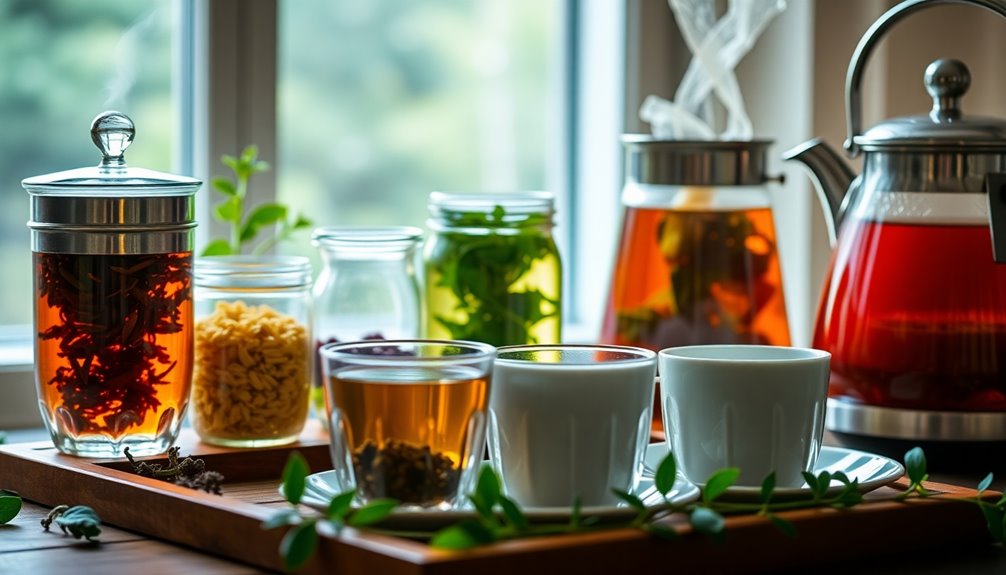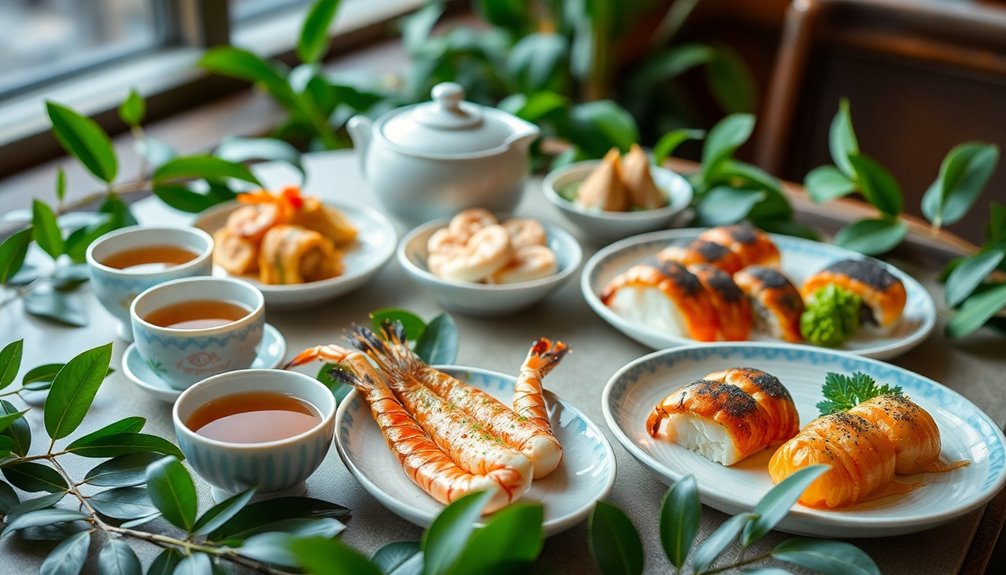Pairing the right tea with your meals can enhance flavors and elevate your dining experience. If you’re having light dishes like salads or seafood, go for green tea. It complements those flavors beautifully. For hearty meals like roasts, robust black tea is your best friend. When indulging in spicy foods, try oolong or rooibos to balance the heat. Don’t overlook unique cheese pairings; pu-erh works wonders with rich cheeses. Experimenting with these combinations can surprise your palate and boost enjoyment. Discovering more about pairing techniques and flavors could lead you to even more delightful experiences.
Key Takeaways
- Pair lighter dishes like seafood and salads with green tea to enhance their delicate flavors and provide a refreshing balance.
- Robust black tea complements hearty meals such as roasts and dark meats, enriching their rich flavors and textures.
- Oolong tea serves as a versatile option, pairing well with both lighter and darker meats, and cleansing the palate with spicy dishes.
- Herbal teas promote relaxation and can enhance the dining experience, while peppermint aids digestion and comfort after meals.
- Experiment with unique tea pairings to discover delightful surprises, while ensuring ethical sourcing for sustainable selections.
Introduction
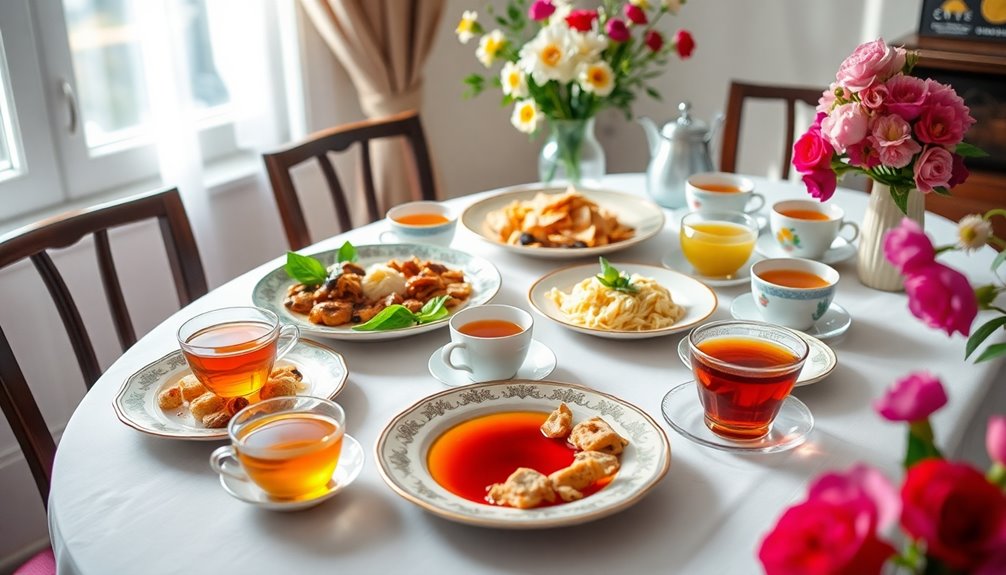
Tea pairing can elevate your dining experience in ways you mightn’t expect. By carefully selecting tea to complement or contrast the flavors of your food, you can create a truly memorable culinary experience. Additionally, certain teas like peppermint oil can aid in digestion, making them an excellent choice after a meal. Studies have shown that some teas, such as green tea, may also provide antioxidants that contribute to overall health. Drinking herbal teas may also promote relaxation, enhancing your overall meal enjoyment.
Understanding the six main types of tea—white, yellow, green, oolong, black, and pu-erh—helps you make informed pairing choices. For instance, green tea‘s delicate, grassy notes work wonderfully with light, delicate foods like sushi or salads. Additionally, some teas, like collagen-rich options, can even support skin health when enjoyed with meals. On the other hand, robust teas like black tea can stand up to heartier meals, such as grilled meats or rich stews.
Exploring seasonal and cultural dishes can inspire your tea pairings, aligning flavors with occasions and enhancing the overall meal. For the best results, pay attention to brewing techniques and temperature control, as these factors are crucial for maximizing the flavors of both the tea and the food it accompanies. Additionally, consider the effects of health benefits of tea consumption, as certain teas can enhance digestion and overall well-being during meals.
Tea Enhances Culinary Experiences

Pairing the right tea with your meal can transform an ordinary dining experience into something truly special. The art of tea pairing enhances your culinary experience by matching the tea’s weight with the food. For instance, lighter green tea complements delicate seafood, while robust black tea enhances rich meats. This thoughtful approach allows you to explore unique combinations, creating an unforgettable meal. Regularly incorporating essential oils like lavender can also promote relaxation, enhancing your overall dining experience. Additionally, be mindful of saturated fats in certain desserts, as they can affect your overall health. Drinking espresso after meals can also aid in digestion and provide an invigorating end to your dining experience.
Don’t shy away from experimenting with oolong tea, as it’s versatile enough to pair well with both lighter dishes and darker meats. When it comes to spicy foods, you’ll find that certain teas can balance the heat, offering a refreshing contrast. Additionally, herbal teas like peppermint can be a perfect match for spicy Asian dishes, providing a soothing effect on the palate.
For breakfast foods, consider pairing lighter teas that harmonize with the meal’s flavors. Additionally, incorporating flower teas, known for their health benefits, can elevate your dining experience by providing unique flavors and promoting overall well-being.
Moreover, understanding the digestive benefits of specific teas, like pu-erh, can elevate your dining experience even further, especially after a heavy meal. By exploring seasonal and cultural inspirations, you can discover diverse cuisines that encourage creativity in your tea pairings.
Ultimately, the right tea not only enhances flavor profiles but also adds depth to your culinary experiences, making every meal an occasion worth savoring.
Tea Complements Savory Dishes

Enhancing your savory dishes with the right tea can elevate your meals to new heights. When you dive into rich, hearty dishes like Sunday roast or dark meats, black tea is your best friend. Its robust flavors enhance these savory meals, making every bite more enjoyable.
For lighter fare, green tea shines with its vegetal notes, perfectly complementing seafood and light meats, allowing the delicate flavors to take center stage.
Oolong tea offers incredible versatility in food pairings. Lighter oolongs work wonderfully with salty dishes and seafood, while darker varieties suit richer meats like duck, adding depth to your meal.
If you’re indulging in greasy or oily foods, pu-erh tea is a fantastic choice. Its earthy flavor not only complements these dishes but also aids digestion afterward.
Lastly, consider smoky teas like Lapsang Souchong when you’re serving BBQ meats or dark chocolates. These teas bring a harmonious balance to strong flavors, enhancing your overall dining experience. Additionally, pairing tea with dishes like Mafe (Senegal) can create a delightful culinary experience, as the rich, creamy peanut stew complements the bold flavors of certain teas.
Unexpected Tea and Cheese Pairings

When you’re exploring the world of cheese, you might be surprised to discover how wonderfully it pairs with different types of tea.
Start with green teas, which enhance the delicate flavors of soft cheeses like brie. This pairing creates a refreshing balance perfect for light meals, especially in environments with improved air quality. Additionally, maintaining a clean environment can support senior safety by minimizing distractions during meals. Air purifiers can significantly improve indoor air quality, making your dining experience even more enjoyable. Moreover, ensuring that your home has proper insulation can help maintain a comfortable atmosphere while you enjoy your tea and cheese.
Next, oolong tea shines with its versatility; lighter oolongs complement creamy cheeses, while darker varieties match aged cheeses and pungent blue cheese.
If you’re feeling bold, try robust black tea, like Assam, with sharp cheeses such as aged cheddar or gouda. The tea’s bold flavors enhance the richness of the cheese, making for a delightful combo.
For something more subtle, white teas pair beautifully with mild cheeses, like fresh goat cheese or ricotta, allowing their gentle flavors to shine without overpowering.
Lastly, don’t overlook pu-erh tea. Its earthy tones work wonders with stronger cheeses, cutting through the richness of aged parmesan or pungent blue cheese.
In addition to these pairings, consider the impact of air quality improvement on your overall dining experience, as a cleaner environment can enhance your tasting pleasure.
The key to these unexpected pairings lies in the balance of flavors, so don’t hesitate to experiment. You might just find a new favorite combination that elevates your cheese experience.
Pairing Tea With Spicy Foods
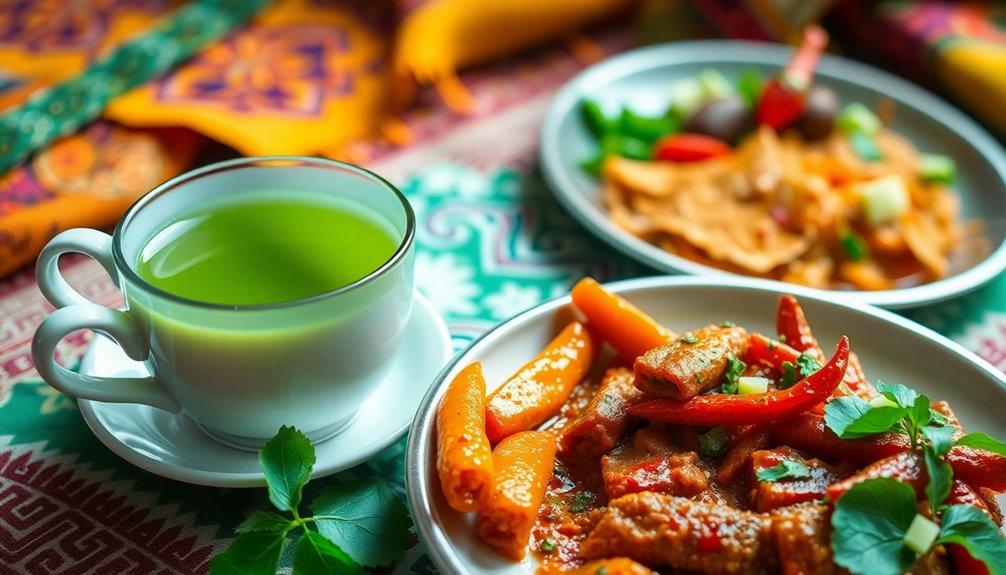
Exploring tea pairings doesn’t stop at cheese; it also extends to spicy foods, where the right tea can elevate your dining experience. When you’re savoring spicy dishes, oolong tea and pu-erh are excellent choices. Their palate-cleansing properties refresh your taste buds, making each bite feel new and vibrant. Additionally, rooibos tea, which is caffeine-free, can be a soothing option that complements the heat without overwhelming the palate. Furthermore, certain essential oils can enhance the overall dining experience by promoting relaxation and calmness, particularly when using oils with mood enhancement benefits. Chia seeds can also be a great addition to your spicy meals, as they offer health advantages that support digestion and overall wellness.
Smoky teas like Lapsang Souchong work wonders with spicy fare, enhancing the heat while providing a contrasting flavor profile that adds depth to your meal. If you’re enjoying grilled spicy meats, consider green teas, especially Hojicha. Its roasted notes balance the heat, creating a delightful harmony of flavors.
For those spicy Indian dishes, chai is your best friend. Its warming spices harmonize beautifully with the heat, delivering a comforting and cohesive dining experience.
Lastly, don’t forget about cooling herbal teas. Options like chamomile or mint can soothe your palate after indulging in spicy foods, mitigating the heat while offering a refreshing finish. Additionally, be mindful of using certain oils that could be harmful when cooking, as some essential oils can be toxic if ingested.
Practical Applications
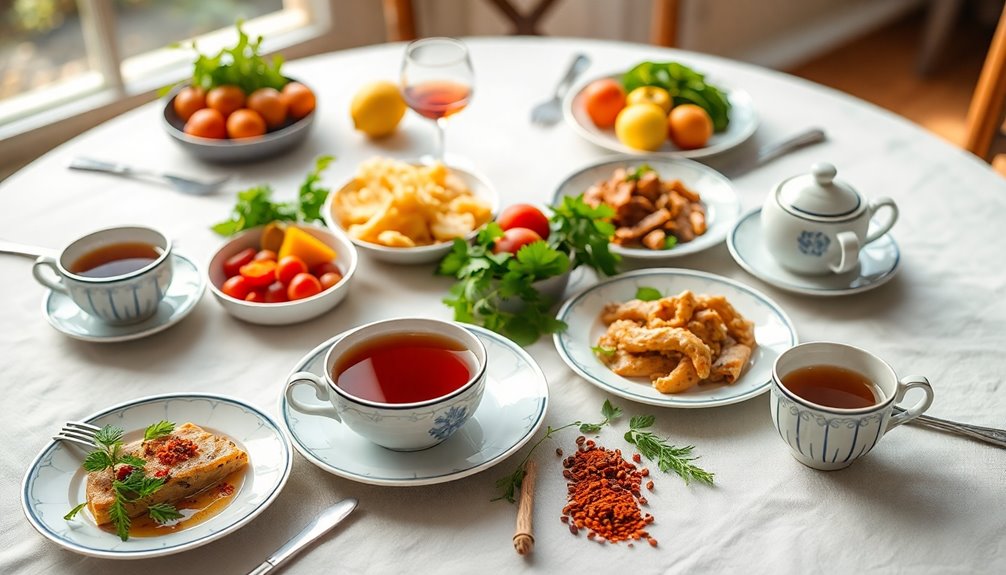
Practical applications of tea pairings can transform your meals into memorable culinary experiences. To create delicious pairings, match the weight of your tea to the weight of your food. For lighter dishes, choose light teas like green tea, which offers vegetal notes that enhance fresh flavors. In contrast, robust teas like black tea work wonderfully with hearty meals, enriching their richness. Additionally, the practice of ethical sourcing in the beverage industry can inspire your choices, encouraging you to select teas from brands that prioritize sustainability. Aromatherapy techniques can also enhance your dining atmosphere, making the experience more enjoyable, as certain scents can evoke feelings of relaxation and enhance appetite. Understanding the flavor profiles of various teas allows you to select the ideal companion for your dishes, while considering air purifier features can help maintain an optimal dining environment by reducing allergens and odors. Experiment with unique combinations, like pairing smoky black teas with dark chocolate or fruity green teas with fresh salads, to discover delightful surprises.
Seasonal inspirations also play a key role; for instance, serving chai with spicy Indian cuisine or green tea with seafood aligns perfectly with traditional flavor profiles. Additionally, pairing herbal teas such as peppermint tea with your meals may enhance digestion and overall comfort, benefiting from the emotional wellbeing that certain aromas can provide.
Don’t overlook brewing techniques either. Adjusting water temperature and steeping time ensures you extract the best flavors from your selected tea. Proper brewing maximizes the potential of your tea pairings, ensuring they complement your meals beautifully.
With these practical applications, you’ll elevate your tea and food experiences to new heights, delighting your palate with every sip and bite.
Conclusion
Incorporating tea into your meals can elevate your dining experience in surprising ways. Whether you’re enjoying savory dishes, indulging in cheese, or tackling spicy flavors, the right tea can enhance each bite. Don’t be afraid to experiment and discover unique pairings that delight your palate. Remember, tea isn’t just a drink; it’s a versatile companion to food. So go ahead, brew a cup and transform your next meal into a memorable feast!


